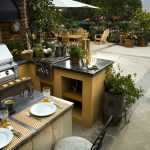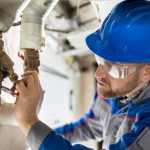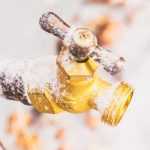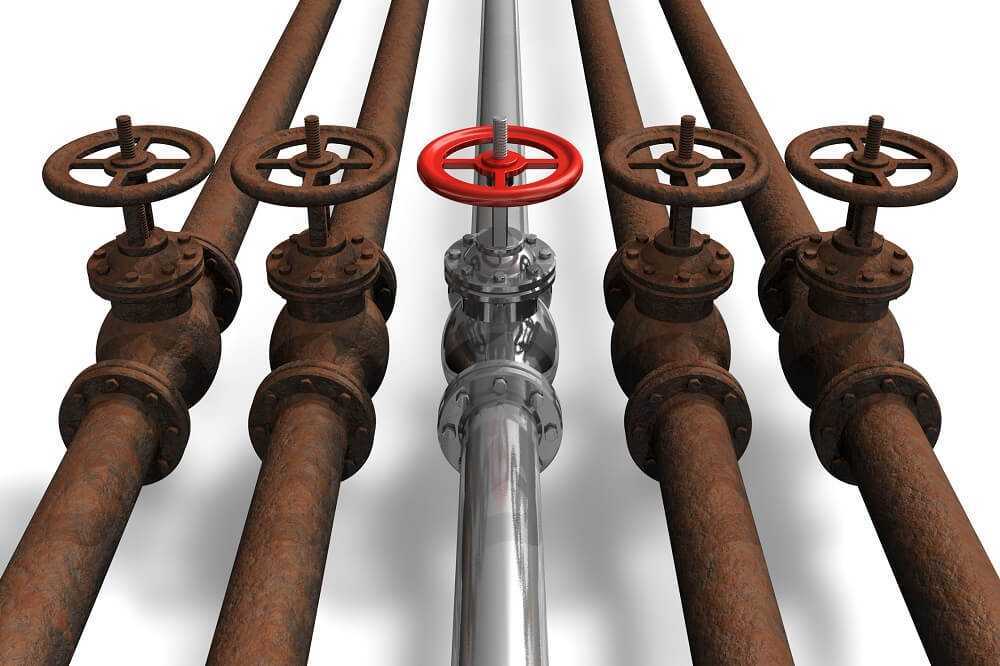Dealing with the environmental effects of our daily lives is a growing concern in the 21st century. As professionals at Dan’s Plumbing, we’ll be discussing 30 sustainable methods to address this issue, you can easily implement in your living space. A fraction of these involve eco-friendly plumbing installations that preserve one of our most precious resources: water. For now, let’s take a closer look at the first ten.
Contents
- 1. Low-Flow Shower Heads
- 2. Dual Flush Toilets
- 3. Water-Saving Taps
- 4. Tankless Water Heaters
- 5. Rainwater Harvesting Systems
- 6. Gray Water Recycling
- 7. Solar Water Heaters
- 8. High Efficiency Dishwashers
- 9. Drip Irrigation Systems
- 10. Efficient Washing Machines
- 11. Eco-Friendly Insulation Material
- 12. Water-Sensing Appliances
- 13. Composting Toilets
- 14. Energy Star Appliances
- 15. Smart Home Systems
- 16. On-Demand Circulation Pumps
- 17. PEX Pipe Plumbing
- 18. Recycled Steel Plumbing
- 19. Sanitary Drainage Systems
- 20. Condensing Boilers
- 21. Efficient Garbage Disposal
- 22. Tap Flow Reducers
- 23. Eco-Friendly Pipes
- 24. Water Leakage Detectors
- 25. Lead-Free Plumbing Fixtures
- 26. Low-Flow Toilet Converter
- 27. Green Plumbing Fixtures
- 28. Drought Resistant Landscaping
- 29. Energy-Efficient Pool Systems
- 30. Radiant Floor Heating
- In Conclusion
1. Low-Flow Shower Heads
Conventional showerheads typically use around 15-18 litres per minute. Reducing this figure could drastically lower your water consumption and save precious energy. With a low-flow showerhead, water usage is curtailed to about nine litres per minute without compromising the quality of your baths. It attracts a dual benefit: benefiting your pocket and aiding Environmental conservation efforts.
2. Dual Flush Toilets
On average, toilets utilise about 30% of indoor water in Australian homes. The dual flush toilet system offers a solution by providing two flushing options: a half flush for liquid waste and a full flush for solid waste. In terms of sustainability and water management, this installation could decrease toilet water consumption by up to 67%.
3. Water-Saving Taps
Water-saving taps or aerators are simple yet effective environmental technology contraptions that aid water conservation by controlling the flow rate of your taps – reducing it to as little as 1.9 litres/minute from about 18 litres/minute–while maintaining water pressure for effective use.
4. Tankless Water Heaters
Tankless water heaters offer an eco-friendly option for heating only the required amount of water on demand, resulting in significant energy conservation contrary to traditional models that heat and store large volumes of water, often resulting in energy waste.
5. Rainwater Harvesting Systems
Among sustainable technologies, rainwater harvesting is a notable one. By collecting and storing rainwater, homeowners can offset reliance on main water supplies, thereby lending support to water and environmental management. Uses for harvested rainwater range from irrigation to flushing toilets and more.
6. Gray Water Recycling
“Greywater” refers to domestic wastewater excluding sewage. Recycling such water adds another dimension to sustainable development. This water can be treated and reused for irrigation, flushing toilets, or even laundry, which would contribute significantly to water conservation efforts.
7. Solar Water Heaters
Solar water heaters utilise renewable and abundant energy from the sun to heat your home’s water, drastically cutting back on conventional electricity or gas usage. It’s an environmentally friendly option that reduces energy costs while promoting sustainable energy use and contributing towards a sustainable economy and environment.
8. High Efficiency Dishwashers
Modern high-efficiency dishwashers can use as little as 11 litres of water per load with energy-efficient cycles, a significant reduction from traditional models that use around 30-45 litres. Swapping your standard dishwasher for a high-efficiency model could lead to economic and natural environment benefits.
9. Drip Irrigation Systems
Drip irrigation systems offer an efficient method of watering plants by delivering water directly to their root zones. This approach wastes far less water than traditional sprinkler systems making it perfect for individuals concerned with environmental science, particularly water conservation and management.
10. Efficient Washing Machines
Last but certainly not least in our discussion today are efficient washing machines, especially important for households with sizeable laundry load. High-efficiency machines require less water and energy compared to standard models, making them a stellar addition to our list of eco-friendly ideas that professionals can easily install in homes.
11. Eco-Friendly Insulation Material
When it comes to plumbing, eco-friendly insulation material is a great way to conserve energy. Not only does it limit the heat loss or gain from your hot/cold water pipes, but it may also protect them from freezing in cold weather. Eco-friendly insulation materials are often made from recycled and renewable resources such as wool or plant-based materials, which are healthier alternatives to fibreglass. By doing so, we make a positive impact on our environment, adhere to sustainable development principles, and promote energy conservation.
12. Water-Sensing Appliances
Water-sensing appliances, such as taps with motion sensors or dishwashers that optimize water use, are becoming increasingly popular ways to conserve water in the home. These ingenious devices detect the required water level for different activities and automatically adjust their output. Benefits of these appliances are twofold: they reduce water waste and help you save on your utility bills. These appliances align well with sustainable technologies and environmental engineering approaches aimed at preserving natural resources.
13. Composting Toilets
One of the greenest initiatives within the plumbing industry is the shift toward composting toilets. These innovative devices are ideal for areas where traditional sewage systems are not feasible or desired. They use minimal amounts of water and transform waste into nutrient-rich compost that’s safe for non-edible plants. Composting toilets can contribute significantly to waste management concerns globally, not only providing a practical solution but also furthering ecological sustainability.
14. Energy Star Appliances
These appliances, marked with the Energy Star logo, have been independently certified to save energy without sacrificing features or functionality. They include dishwashers, toilets, and water heaters designed to reduce your greenhouse gas emissions and other pollutants caused by inefficient uses of energy. These appliances contribute significantly toward efficient energy use and can play a role in sustainable development.
15. Smart Home Systems
Smart home systems are a significant part of environmental technology nowadays. They allow homeowners to control their water and energy usage more directly, promoting efficiency in areas such as heating, ventilation, and even water conservation. Thanks to these advanced technologies, we can now automatically turn off lights when they’re not needed or reduce our water usage during certain hours, ultimately fostering an economy that’s more harmonious with our environment.
16. On-Demand Circulation Pumps
An on-demand circulation pump is an energy-efficient way to provide hot water throughout your home without the need for constantly running pipelines and wasting water. Installed on your existing hot water heater, it cleverly recirculates the cooled water back to the heater for reheating. By reducing the wait time for hot water, you conserve both water and energy, aligning perfectly with principles of sustainable energy usage.
17. PEX Pipe Plumbing
PEX pipes, made from cross-linked polyethylene, have revolutionized plumbing installations with their flexibility and durability. It offers a highly efficient medium for hot or cold water transport, reduces heat transfer better than conventional pipes, and doesn’t corrode over time making it suitable for harsh environments where other materials may fail. Their applicability in building engineering makes it great for those aiming to impact eco-efficiency.
18. Recycled Steel Plumbing
Recycled steel plumbing not only contributes to saving natural resources but also promotes sustainability and environmental management. It plays a significant role in reducing the carbon footprint of construction activities while maintaining the high-quality standards required for plumbing installations. By choosing recycled steel plumbing material over traditional types, we’re making a conscious decision to promote sustainable development strategies.
19. Sanitary Drainage Systems
Sanitary drainage systems are engineered to dispose of waste water from homes and businesses efficiently. Modern systems incorporate advanced environmental technology to protect clean water sources from contamination, ensuring the water’s safe return to the natural environment. These systems are designed with principles of water management, sustainability, and environmental protection at their core.
20. Condensing Boilers
Condensing boilers offer high-efficiency space heating and domestic hot water production while minimizing energy waste. They work by capturing heat from exhaust gases that would usually be discharged into the atmosphere, using it to preheat cold water coming into the system. The condensing boiler plays a significant role in both energy conservation and reducing human impact on the environment – significant steps towards sustainable living.
21. Efficient Garbage Disposal
When you’re aiming to make your plumbing more eco-friendly, efficient garbage disposal is vital. It means getting rid of waste in a way that’s kind to the environment. Fortunately, there are garbage disposal systems designed to minimise their impact on the earth. These units use less electricity, ultimately decreasing carbon emissions. They also grind waste into finer particles, reducing water and blockage issues in your drainage system.
22. Tap Flow Reducers
Are you aware of how much water you use every day while doing simple tasks like washing dishes or hands in the sink? You’d be surprised! With tap flow reducers, like low-flow aerators, you can easily cut down on water consumption by controlling the quantity released from your taps without affecting your activities significantly.
23. Eco-Friendly Pipes
Piping is an integral part of your home’s plumbing system. Choosing environmentally friendly pipes means less water contamination and longer lifespan. Recycled piping materials, such as those made from sand and recycled plastic, are great ecological options to consider.
24. Water Leakage Detectors
A water leakage detector is another must-have for anyone wanting to conserve water. These devices quickly alert you when there’s a leak in your pipes before it escalates into a major issue—helping save both water and repair costs.
25. Lead-Free Plumbing Fixtures
Lead can pose serious health hazards if ingested and used to feature heavily in plumbing fixtures and systems. Nowadays, opting for lead-free plumbing fixtures is a healthy green solution that helps protect your health while also contributing to the general well-being of our environment.
26. Low-Flow Toilet Converter
Converting your current toilet to a low-flow alternative can save a significant amount of water. A low-flow converter kit helps by adjusting the amount of water used per flush, effectively reducing water wastage. It’s an easily implemented modification that will make a big difference to your water consumption.
27. Green Plumbing Fixtures
Revamping your bathroom? How about opting for green plumbing fixtures? From shower heads to taps and toilets, there are an array of eco-friendly fixtures — all designed with significantly reduced water flow rates — that can help you conserve water without compromising on comfort or functionality.
28. Drought Resistant Landscaping
Drought-resistant landscaping complements your green plumbing initiatives. By choosing drought-tolerant plants and landscaping techniques, you reduce the need for excessive watering and encourage natural rainwater utilisation. Thus, saving one of our most precious resources – water.
29. Energy-Efficient Pool Systems
If you have a swimming pool, consider upgrading to a more energy-efficient system. Energy-saving pool heaters, pumps, and covers not only reduce your energy consumption but also deliver long-term cost savings through reduced utility bills.
30. Radiant Floor Heating
Radiant floor heating is an innovation worth exploring when going green with your home’s plumbing system. This underfloor heating system uses tubes of hot water below the floor surface to heat a room, reducing energy consumption due to its efficiency in retaining heat within the room for longer periods compared to traditional heaters.
In Conclusion
Understanding the importance of green plumbing and integrating these measures into our homes can make substantial changes to our environment, economy, and health. While some alterations may seem minor individually, they collectively have a significant impact. So, take that eco-friendly step with Dan’s Plumbing for cleaner water and a greener Earth!
Dan’s Plumbing is a leading name in emergency plumbing across Australia. We ensure prompt and effective plumbing solutions for residents across Brisbane, Sydney, Melbourne, and the Gold Coast.
- Simple Plumbing Tips When Going on Holidays, Your Aussie Holiday Plumbing Checklist - October 26, 2024
- Preventing Corrosion in Your Pipes: Professional Pipe Inspection Services - September 26, 2024
- Upgrading to Smart Plumbing Technology – Professional Smart Home Integration - September 26, 2024
Related posts:
 Nifty Outdoor Plumbing Ideas to Enjoy Your Aussie Home and Outdoor Space this Summer
Nifty Outdoor Plumbing Ideas to Enjoy Your Aussie Home and Outdoor Space this Summer
 The Benefits of Regular Plumbing Inspections and Why Professionals Recommend Them
The Benefits of Regular Plumbing Inspections and Why Professionals Recommend Them
 Why You Should Consider Installing a Rainwater Tank – Make Installation a Breeze with Dan’s Plumbing
Why You Should Consider Installing a Rainwater Tank – Make Installation a Breeze with Dan’s Plumbing
 Preparing Your Plumbing for Melbournes Winter Weather where Snow is Not Really Ever an IssueTips from the Pros
Preparing Your Plumbing for Melbournes Winter Weather where Snow is Not Really Ever an IssueTips from the Pros
 Detecting Common Sydney Household Plumbing Leaks: When to Call a Professional
Detecting Common Sydney Household Plumbing Leaks: When to Call a Professional
 Why You Should Seriously Consider a Sink Food Disposal System even Though They are Not Common in Australian Homes
Why You Should Seriously Consider a Sink Food Disposal System even Though They are Not Common in Australian Homes



